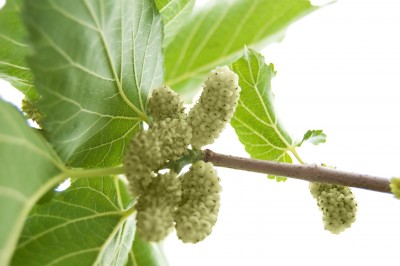White Mulberry - Morus alba

Common Names: White Mulberry, mulberry, common mulberry, Persian mulberry, silkworm mulberry, Morus alba, shahatut, tuta, tuti, dut, toot
Latin Name: Morus alba
Origin: Africa, Asia, Australia, Europe, South America, North America
Short Introduction
White Mulberry originates from present-day China but is now widely cultivated across the globe. It thrives best in slightly humous soil in the sunniest location possible, with consistently moist (but not waterlogged) conditions. Slow-release fertilizers are recommended during growth. Due to its growth habit, frequent pruning is unnecessary; if needed, prune at the end of winter. White Mulberry is one of the latest trees to leaf out and flowers from May to June.
Detailed Description
A traditional Chinese herb valued for its effects against high blood pressure, excessive blood lipids, blood sugar, and even cancer.
Botanical Information
White Mulberry is a short-lived but fast-growing small to medium-sized tree, reaching up to 20 meters tall. Its branches are smooth, thin, and brittle. Lower branches are sessile, angular, and darker in color, while older branches become even darker and the pith turns gray.
Leaves are smooth, glossy, heart-shaped to oval, bright green, palmately lobed, rounded, and serrated or lobed. They can grow up to 20 cm long and 6 cm wide. The stalk is up to 2 cm, densely hairy, and grooved on the upper side. Flowers are small, white, and appear at the end of summer. White Mulberry is self-pollinating. The fruit cluster is about 15-25 mm long, superficially resembling blackberry fruits, but more elongated. As they ripen, these fruits change from green to deep purple or black.
Origin and Distribution
Although native to China, White Mulberry has spread significantly worldwide and is still widely cultivated. It expanded from India to Afghanistan, primarily as food for the silkworm (Bombyx mori), which produces silk. Only recently has it been introduced to the densely populated eastern part of North America, where it has quickly naturalized and become highly invasive, interbreeding with native mulberry species. For centuries, it has also been planted around the Mediterranean and in warmer parts of Central Europe, where frost-hardy varieties have been bred.
Usage / Dosage
White Mulberry was originally cultivated mainly as feed for silkworm caterpillars. Leaf harvesting expanded to Europe, and this tradition is still valued in France. During World War II, mulberry cultivation spread to school gardens (especially in Germany) and all available land was used to harvest leaves. For optimal yield, the trees are often pruned to encourage dense branching.
Thanks to its sweet and tangy fruits, White Mulberry is also grown along roadsides, in gardens, and parks. Written records of its cultivation for silk production in Europe date to the 16th century. On the territory of today’s Czech Republic, mulberry was first cultivated for silk yield in the 17th century, credited to Albrecht von Wallenstein. The silk industry reached a high level in Czechoslovakia, processing up to 500 tons of raw silk annually. This industry was unfortunately discontinued in 1963.
The leaves are also used as forage for animals in dry areas where fresh vegetation is scarce. The fruit is especially popular and can be eaten fresh, cooked, dried, or fermented into wine.
In traditional Chinese medicine, mulberry fruit is used to treat premature graying of hair (due to stress, anxiety, fear, etc.), strengthen internal energy and blood circulation (literally “tonifies blood”), treat constipation and age-related diabetes. The bark is used to treat cough, wheezing, edema, promote urination, and cleanse the urinary tract. Folk medicine also uses it to relieve fever, high temperatures, headaches, and to treat dry or red eyes.
In Asian folk medicine, mulberry root bark is used to prepare antibacterial extracts to detoxify the body after poisoning or eating spoiled food. This antibacterial effect, attributed to a compound called kuwanon, has been studied for its action against Streptococcus mutans, the bacteria causing dental caries. This compound is effective in both water and alcohol extracts, showing comparable results to chlorhexidine and vancomycin against Streptococcus strains.
Similar extracts have demonstrated adaptogenic properties in animal studies, making mulberry potentially useful as an anti-stress remedy. It provides an immediate energy boost, helps combat exhaustion, fatigue, and supports recovery in long-term illnesses or weakness.
Traditional Chinese medicine uses the healing formula called Sang Shu Gen, which is derived from White Mulberry root. This remedy is considered sweet and cooling, and supports the liver meridian. It relieves pain, lowers blood pressure, calms epilepsy, treats oral fungal infections, helps with red eyes and alleviates painful muscle conditions.
U.S. university studies are evaluating mulberry's constituents for their effects on lowering high cholesterol and other blood lipids. Mulberry powder shows significant antioxidant activity in inflammatory conditions. Further research is investigating its role in protecting nerve fibers under chronic stress; so far, both in vivo (animal) and in vitro (lab) studies show a good neuroprotective effect.
Other promising compounds include albanol A, now being tested for its effects on the progression and regression of leukemia—though more research is needed. Compounds like moracin M, steppogenin, and mulberroside A are believed to help reduce blood sugar levels.
Mulberry leaf extract helps restore healthy vascular endothelium function in diabetic animal models, addressing the root causes of these complications at a molecular level. Similar concentrations have shown effects against high blood pressure, blood sugars, and blood lipids in other studies.
With their rich juice and nectar content, mulberry fruits are delicious and highly beneficial for children and adults, making them a quality addition to a healthy diet.
Active Compounds
White Mulberry contains a wide range of compounds, including resveratrol (an antioxidant and antibacterial agent, also being researched for anti-cancer potential), moracin M, steppogenin, mulberroside, albanol A, along with additional flavonoids and glycosides.
Traditional Dosage
To prepare a decoction in traditional Chinese medicine, use approximately 15–30 g of dried herb. This decoction is suitable for external use, compresses, or rinses. Fresh berries may be eaten freely as desired.
